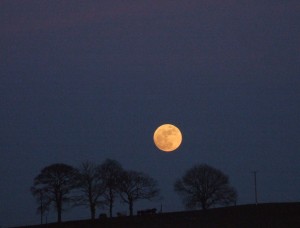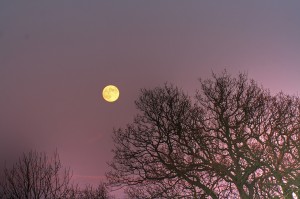
Over the centuries, cultures around the world have given specific full moon names for each month. These full moon names tell us much about the way these early cultures set schedules for hunting, planting and harvesting. They also explain how plants, animals and weather patterns typically behave during a particular month. Photo courtesy FrenchFinds.co.uk/Flickr.
In this post, Seasonal Wisdom reveals some of the old full moon names that were given by the Algonquin tribes from New England to Lake Superior, as well as European settlers and other cultures. Come take a peek.
A Year of Full Moon Names
January: The Wolf Moon
Packs of hungry wolves howling on a cold January night are the inspiration of this full moon name. Other popular names were Old Moon, Ice Moon and Moon After Yule.
February: Snow Moon
February is often the coldest and snowiest month of the year. Other common names were Storm Moon and Hunger Moon, as food reserves ran low and early cultures waited for spring to return.
March: Worm Moon
As the ground thaws, the worm trails that start appearing around now inspired Native Americans’ name for this moon. Other names included Crow Moon, named after the cawing of crows as the weather warms. The Crust Moon describes how March snow can get crusted from daytime thawing and nighttime freezing. The Sap Moon meant it was time to tap the maple trees. And some settlers called this time the Lenten Moon for religious reasons.
Photo by QwinCowper/Flickr
April: Pink Moon
Herb moss pinks and wild ground phlox are early widespread flowers in spring. Their pink color led to this month’s full moon name. Full Sprouting Grass Moon, Egg Moon and Fish Moon were other popular names.
May: Full Flower Moon
April showers bring May flowers. So, it’s little wonder how this month got its name of Flower Month. Other names were Corn Planting Moon and Milk Moon, which showed important farming tasks for the month. Hare Moon was another name, indicating the animals are prevalent now.
June: Strawberry Moon
Strawberries are harvested in North America during this month, so the sweet fruit is honored with a full moon name. Other names were Hot Moon for the steamy weather, and Rose Moon by Europeans as the beloved flowers bloom this month.
July: Buck Moon
Male deer (or bucks) begin to regrow their antlers around now, after shedding them each year. Thus, giving the moon its name. Thunder Moon is another popular name, because of the month’s many storms. Hay Moon signified the July harvest time.
August: Sturgeon Moon
Native Americans named this moon after a large fish called sturgeon, which was readily available in August. Green Corn Moon and Grain Moon were other names that detailed farming and gardening chores. Red Moon was named after the reddish color the moon often appears when rising now.
September: Full Corn Moon or Harvest Moon
Now is the time to harvest corn, leading to the Corn Moon name. The Harvest Moon is the full moon that happens closest to the Autumn Equinox. It’s an especially bright moon, which allows beans, corn, squash and other summer crops to be easily harvested now. Other names include the Barley Moon.
 Photo by PennStateNews/Flickr
Photo by PennStateNews/Flickr
October: Hunter’s Moon
Often called Blood Moon, Hunter’s Moon or Sanguine Moon, because this was the time to hunt and store meat for the long winter. The particularly bright moon was also called the Travel Moon and the Dying Grass Moon.
November: Beaver Moon
This moon gets its name either because beavers build their winter dams now, or because beaver traps are set in November. No one is quite sure. But the other name is Frost Moon. No one from the northern climates has any questions about that name.
December: Cold Moon
The December days are shorter and colder. The nights are longer and increasing in length until the Winter Solstice in the Northern Hemisphere. It’s easy to understand why this moon was often called Cold Moon, Long Nights Moon or Moon Before Yule.
Sources: The Farmer’s Almanac, National Geographic
Learn More: The Chinese Solar Calendar was another traditional way to consider time, and the seasons were tied to the natural world.












Comments on this entry are closed.